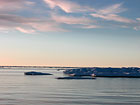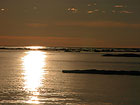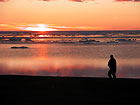

 | |||||||||||||||
|
|
Journals 2006/2007Kirk Beckendorf
September 5, 2006 There are a lot of krill (whale food) in the samples collected yesterday from the area where the whales were seen. Ocean currents from the Pacific Ocean and the Bering Sea carry the krill northward to the coast of Barrow. The water from the Pacific has different amounts of salt and is a different temperature than the Arctic Ocean water. This morning in the lab, Steve looked at his data collected yesterday by the Acrobat to try and find where the Pacific water is moving past Barrow. He also has been looking at satellite images taken yesterday. You can see the same satellite picture using this website. Using the satellite image and the data collected yesterday he is trying to figure out where the Pacific water is going as it comes by Barrow. Find Pt. Barrow, the most northern point of land, on the image. The white parts that look "feathery" are clouds. The more solid looking white areas are sea ice. Off of Barrow is a band of sea ice basically running from SW to NE along the coast. This lends support for a current of water flowing up from the Bering Sea. The krill collected yesterday, and where the whales were seen feeding, is also along the edge of this sea ice to the northeast of Pt. Barrow. Yesterday Craig told me that this spring they tagged a whale with a transmitter so that they could track the whale by satellite. At the following website you can see where the whale has been since May. http://wildlife.alaska.gov/index.cfm?adfg=marinemammals.bowhead After I typed the previous paragraphs, we went out on the boat to do some sampling close to the ice. It was another beautiful day; we found out later that the record high for this day was broken. In Barrow it was 60 degrees. The seas were glassy. We saw more whales and again boated through thousands of short tailed shearwaters and quite a few whales. It is difficult to know how many whales we saw because we went back and forth sampling and may have seen some of the whales more than once. Some areas were loaded with krill and others had almost none. Now it is the job of the scientists to use their data to try and figure out why the krill are located where we found them. As we returned to BASC the sun setting over the icy Chukchi Sea gave us a glittering light show.
|
||||||||||||||


